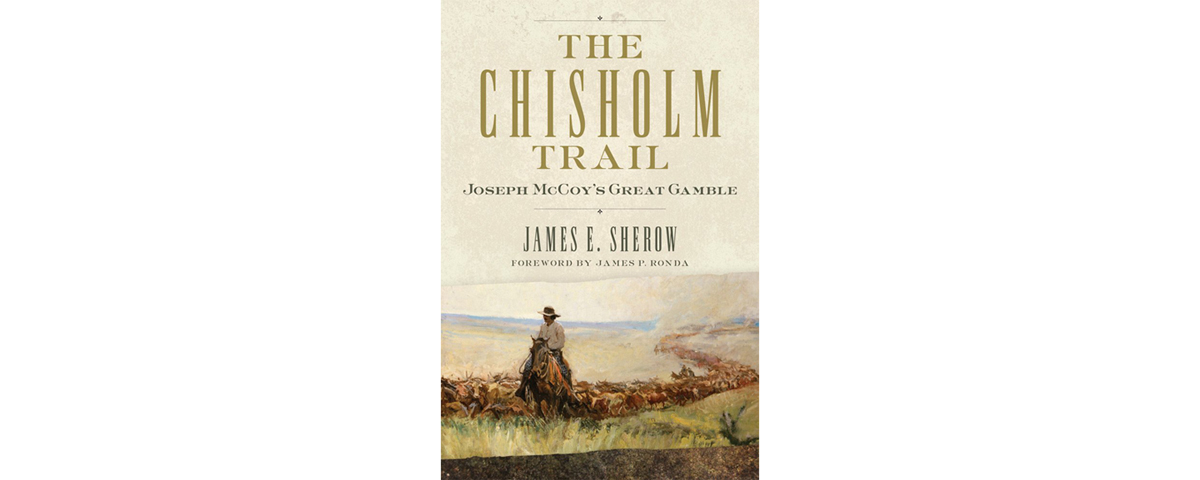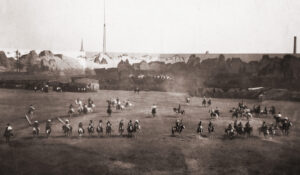The Chisholm Trail: Joseph McCoy’s Great Gamble, by James E. Sherow, University of Oklahoma Press, Norman, 2018, $29.95
As historian James P. Ronda notes in the foreword, period maps of Western cattle trails that prominently feature the Chisholm Trail can be deceptive, as they seem to restrict the cattle era to a narrow passageway. The author breaks free of such “trail as tunnel” hobbles to explore the surrounding landscape and offer a fuller picture of the 19th-century cattle industry—trailing the beef, so to speak, from Texas not only to Abilene and the other Kansas cow towns but also to Illinois, New York, New Jersey and even London. Kansas State history professor James E. Sherow covers the stockmen and trail-driving cowboys, of course, but also everyone and everything else connected to the trade—e.g., town developers, hotel owners, Indians, railroad men, politicians, farmers, grasslands, fires, water, slaughterhouses, disease-carrying ticks, quarantine lines, winter grazing, ice making, cattle breeds, the Panic of 1873 and beef markets everywhere. No player escapes his notice. “Grass, which in essence collects and stores solar energy, fueled the cattle trade,” the author notes in one passage. He also has plenty to say about climate and how one might approach the story of McCoy and the Chisholm Trail “as ecological explication.” In the foreword Ronda deems Sherow’s work “an expansion of the historical imagination,” adding, “The trail line has become a complex, multilayered narrative of connections and consequences, an ecological drama played out on a large stage with an expanded cast of characters.”
Protagonist Joseph McCoy referred to the cattle trade as a faro game, he and older brothers James and William proving eager to venture south from Springfield, Ill., to gamble in the risky business. However, notes Sherow, the trio counted on “mild temperatures and gentle rains, control of Texas fever, steady beef demands in rapidly growing cities, little loss of beef in transit and free access to bountiful grasslands in the public domain.” Joe came up a winner in 1867 when he laid odds the crude burg of Abilene, Kan., would become the hub of the cattle trade, thanks to its rail connection with the Union Pacific’s Eastern Division. “McCoy,” the author writes, “knew it was senseless to undertake a cattle drive unless ecology, technology and markets could all be knitted together.” Still, many pitfalls lay ahead, including an 1868 tick-borne epidemic, the brutal winter of 1870–71 and shady deals by railroad men.
By 1872 Abilene no longer served as the primary outlet for Texas cattle. While McCoy never regained the riches he’d started out with in 1867, he kept his hand in the pot. In the spring of 1872 the Wichita city council hired him to promote the advantages of shipping cattle from that Kansas cow town, and while McCoy had no fondness for Indians, in December 1880 the Cherokee Nation hired him to manage its cattle grazing tax. In November 1884 he was one of more than 60 delegates from Kansas at a national convention of cattlemen in St. Louis. “He had come to relish his role as a cattleman’s sage, a man of wisdom in all aspects of the cattle trade,” writes Sherow, who adds, “McCoy always considered the creation of the outlet in Abilene and the marking out of the Chisholm Trail to be his greatest accomplishment.”
—Editor





